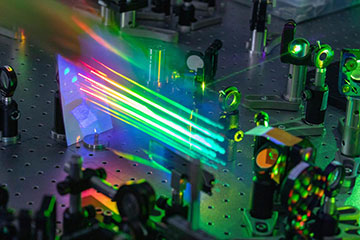
Ultrashort-pulse lasers used at the Physics Department of the Politecnico di Milano to study photovoltaic cells. [Image: Politecnico di Milano]
The most common type of solar panel on the market is rigid, durable, and made of crystalline silicon, which certainly has its advantages for solar farms and rooftop solar systems. But there is growing interest in flexible solar cells that can conform to any surface, such as the roof of a car or on the outside of wearable electronics.
Solar cells made with organic materials have shown promise in this regard, as they exhibit good mechanical bending stabilities and conformability. In a recent study, an international team of researchers has developed a new type of organic solar cell with relatively high efficiency combined with very low energy losses—potentially helping to address a major challenge that has impeded the technology’s commercialization (Nat. Commun., doi: 10.1038/s41467-021-22032-3).
Losses limiting efficiency
Beyond their flexibility, organic solar cells also have the advantages of low manufacturing costs and abundant building-block materials. They boast the theoretical potential to provide electricity at a lower cost than first- and second-generation solar technologies.
“On the downside, organic materials are not good conductors of electricity, and the physics of aggregates of organic molecules is much more complex than that of crystalline solids,” said study author Nicola Gasparini at Imperial College London, U.K. “This has led so far to a power conversion efficiency of organic solar cells significantly lower than their counterparts based on inorganic semiconductors, such as silicon.”
In particular, the reduction of energy and voltage losses—some being unique to organic photovoltaics—remains an imperative area of improvement. Gasparini and his colleagues aimed to find a novel combination of organic materials with just the right properties to reduce these losses and boost efficiency.
Dealing with something special
The researchers designed and fabricated a solar cell with two photoactive organic materials: the copolymer WF3 as electron donor and the small molecule O-IDTBR as electron acceptor. The materials were finely blended and intermixed throughout the device following a standard bulk heterojunction approach using low-cost and readily available technologies.
A standard motto in the photovoltaics community states that a good solar cell should work as a good LED, since the processes of extracting charges upon illumination and of emitting light upon charge injection should be equivalent.
“Surprisingly, we could see the electroluminescence with our bare eyes—something extremely rare in organic photovoltaics,” said study author Franco V. A. Camargo at Politecnico di Milano, Italy, which is when “we knew we were dealing with something special.”
A universal model
The researchers’ device had a power conversion efficiency of approximately 12%, which falls short of the maximum reported value of 17% for organic solar cells. But more importantly, they say, it showed very low nonradiative voltage losses—as demonstrated by the marked electroluminescence—and photocurrent losses with an external quantum efficiency of more than 80%.
Further analysis with several advanced spectroscopic techniques and modeling approaches revealed that the relatively high performance arose from an optimal adjustment of the charge transfer state energy. The model is universal for any combination of donor and acceptor materials used for organic solar cells and can be employed to optimize performance.
“The next step is to extend this study to highly efficient organic solar cells and multicomponent organic solar cells, as well as apply the model to new materials to help identify promising combinations,” said study author Giulio Cerullo at Politecnico di Milano.
